Danish Superliga is widely known as the home to plenty of talented youngsters – including Nordsjælland’s very own, Mohammed Kudus. The 2000-born Ghanaian player is another product of the famous Right to Dream Academy which has produced a host of incredible talents.
The midfielder-cum-striker was featured quite regularly last season, appearing in 30 matches and contributing three goals and two assists in all competitions for the senior side. This season his numbers go up quite significantly as he has scored 10 goals and registered one assist in 21 matches in all competitions. He has become much more vital for the side that’s currently managed by Flemming Pedersen and it’s quite obvious that this season is his breakout one. It certainly won’t be surprising if the young Ghanaian has top European clubs keeping tabs on him and there could be a possibility of him making a big move as well in the summer. Whether or not that would happen in the future, we shall see.
In this tactical analysis/scout report, we’ll be taking a deeper look at Kudus’ attributes that make him such a pleasure to watch on the pitch as well as the tactics behind his outstanding performances this season.
Nordsjælland’s tactics and Kudus’ role
Nordsjaelland usually play with a 3-4-3 formation with Kudus usually playing as the striker with a false nine role. At certain matches, they also employ a 4-3-3 or 3-4-1-2 formation although both formations are essentially the same as the 3-4-3 formation (one of two central midfielders become wing-back in 4-3-3 and Kudus playing as an attacking midfielder in 3-4-1-2), although on paper they may look a bit different. The approaches in offence, defence, and transitions are the same regardless of the formation.
Sometimes Kudus is also played as a central midfielder, an attacking midfielder (if 3-4-1-2 formation is used), or a winger. However, playing as a striker in a false nine role is his main thing at the moment with Nordsjælland and he really thrives in that position and role.
Nordsjælland mainly defend with a high block and a rather aggressive man-oriented pressing upfront. They’ll look to maintain compactness and stay narrow by overloading the middle as well as man-marking the central options (pivot and ‘8’s), thus restricting central access and forcing the opposition to play around the block. Their defensive approach are both option-oriented and passing lane-oriented.
They also tend to play from the back and are rather patient with the ball, moving the ball around and looking for gaps they can exploit and slowly moving forward and working their way into the box. However, they’re quick on the break and the pace of the forwards can really be dangerous in transitions. Nordsjælland mainly look to combine in the half-spaces and on the flanks although it’s not rare to see them play through the tight spaces in the middle as well.
Kudus is mainly tasked as the player to link play and distribute in advanced areas as well as create chances, hence why he drops to receive very often. Scoring goals may be secondary, but that doesn’t mean he completely abandons that part of the game. As mentioned previously, he already has a pretty decent goal tally with 10 goals already in 21 matches this season. He’s clearly much sharper in front of goal than in the previous season. For such a creative player, it may also look rather confusing/surprising that he only has one assist to his name so far this season. Well, it’s because creativity is not only measured through the number of assists he makes. Kudus produces a lot of key passes and progressive passes that not only help his team progress the ball, but are also important in the creation of goalscoring chances. We’ll talk more about his passing ability later in this tactical analysis/scout report.
Pros and cons of his physicality
Kudus is 1.75m (5’9″) tall with a medium build and decently-developed upper and lower muscles (though not quite particularly-developed yet). He seems to be a naturally athletic player and despite not having a large frame or bulky build, he does possess rather impressive strength and power. His lower body power can definitely be seen by his outstanding burst of acceleration and blistering pace over a medium-long range as well as his ability to generate powerful shots and sharp passes.
Kudus is both quick when accelerating and decelerating. He can come to a complete stop after sprinting and burst forward again very quickly. This is the trick he often uses against defenders as he can create separation from his defender or render his defender off balance in 1 v 1 duels.
Despite his explosiveness, he still lacks the ability to win aerial duels. His rather small stature along with poor judgment of aerial balls more often than not result in him getting dominated in the air by taller, stronger opponents or just simply mistiming his jump and failing to connect his head with the ball. In regards to his technical ability, his heading ability is still rather poor. This can be seen by his lack of ability to direct the ball with his head and usually the lack of power he can generate with his header. Though it’s not the most important aspect of his game, this area should not be overlooked as, if developed properly, it could really give him surprising advantages in the game.
As mentioned before, despite his rather small stature, Kudus still possesses quite decent strength. On the ground, Kudus is still able to hold off opponents with similar stature while retaining the ball. He uses his body well to protect the ball and is often skilled and quick enough to swiftly turn and beat his defender. However, again, bigger and/or stronger opponents can still give him some trouble and outmuscle him in physical duels. He’s especially struggling against defenders who defend against him with a very aggressive approach and allow him no time at all on the ball, immediately making a challenge on him whenever he receives the ball. But of course, Kudus is quite smart and whenever he goes against this kind of defender, he’ll use his movements and take advantage of his explosiveness. Usually, this kind of defender would follow him around and will leave his position when Kudus drops to receive and that way space behind the defence opens up. Kudus will usually play with a quicker approach, using fewer touches so that his marker doesn’t have much time to react to his actions.
It’s quite obvious that Kudus is very well-coordinated, very agile, and has excellent body balance. He doesn’t go down easily despite being on the receiving end of a rather heavy body charge and he certainly can glide past defenders effortlessly. His excellent agility, balance, and coordination allow him to manoeuvre pretty much anywhere he wants with ease and they are certainly useful against big, slow defenders. He has excellent control of his body and he can use it to trick his opponents with his body feints or protect the ball.
Kudus is also an energetic player with fairly impressive stamina which results in pretty stable performance throughout the 90 minutes. Kudus presses a lot in the game, he drops a lot, and he roams around a lot, and a lot of times in the game he can be seen sprinting back and forth to win the ball and then get back forward to present himself inside the box or to chase the ball carrier and recover the ball if he loses the ball in advanced areas. There’s usually a small but insignificant drop of performance in the second half (usually late in the game), usually seen by the fewer amount of sprints he makes, reluctance to track back, and his body language.
Ball control and dribbling
Kudus’ strongest attributes in the game are definitely his technical ability which includes his touch and control of the ball, dribbling, passing (short and long), ball-striking ability, and even ball-winning ability. But his neat ball control and dribbling are the ones that stand out the most.
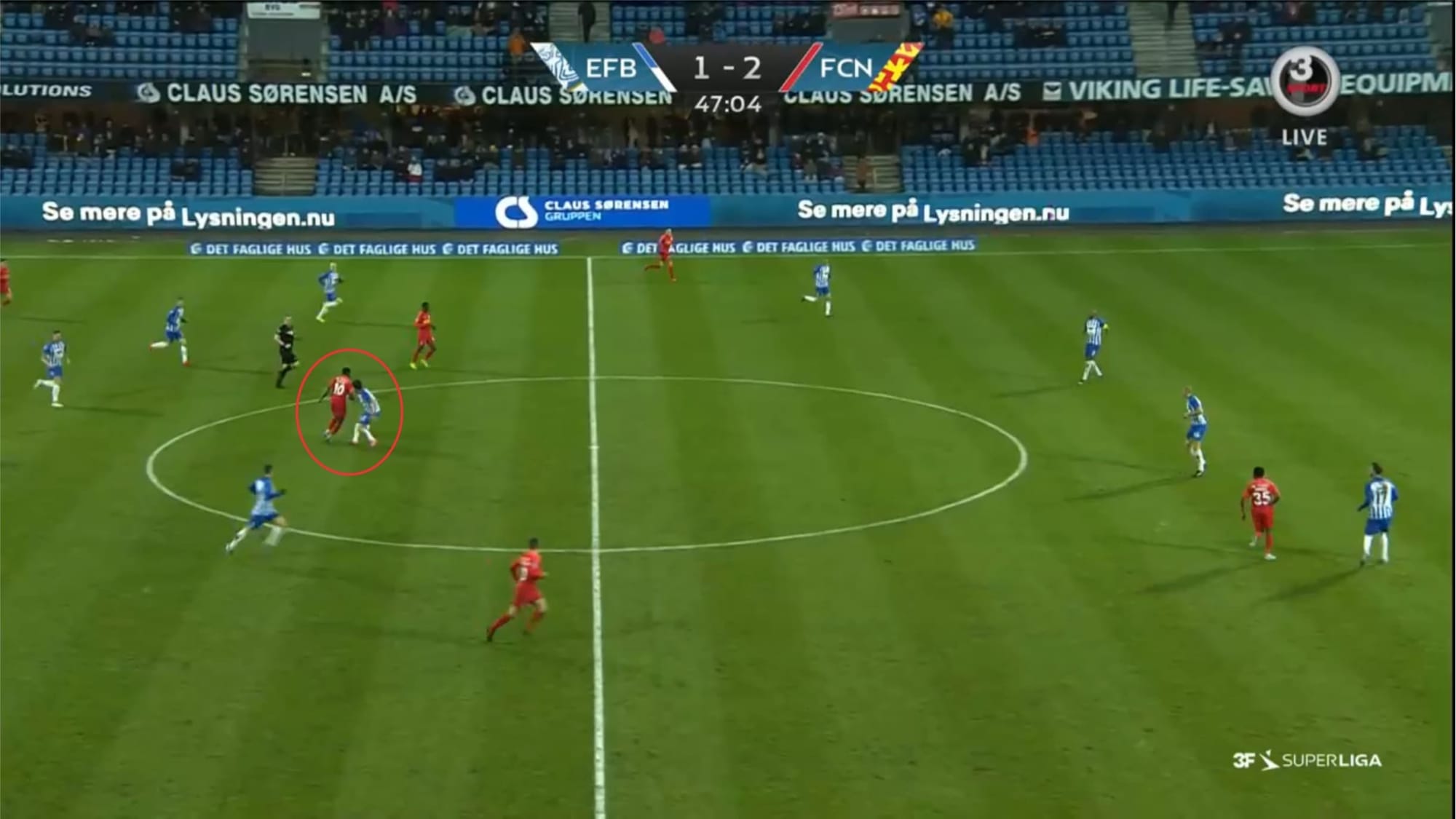
The 19-year-old Ghanaian footballer just seems to have a natural flair and very high confidence on the ball. He has bags of tricks up his sleeve and he’s not afraid to pull some tricks to beat one or multiple defenders. Not only does he have exquisite touch and control of the ball, but he also has excellent coordination and control of his body as well as explosiveness as mentioned before in this tactical analysis/scout report. This allows him to be change speed and directions quickly and effortlessly, often rendering his defender(s) off balance. His ability to use both feet well when controlling the ball and dribbling also allows him to be more flexible when moving with the ball as he can pretty much move to any direction he wants. This makes him quite hard to predict as he can cut to either foot and strike the ball. With his excellent ball control and dribbling skills plus his impressive body and speed control, he’s not only strong in 1 v 1 attacking duels, but he’s also proficient in retaining the ball in tight spaces and escaping pressure.
Statistically, Kudus averages an impressive amount of 19.07 attacking duels per game with an also impressive success rate of 42%. The 2000-born wonderkid also registers an average of 6.93 dribbles per game with a success rate of 59.6% which is quite magnificent. This shows that the player both likes to take on opponents and is quite effective in doing so.
However, at times, Kudus can get a bit too confident on the ball which does affect his decision-making a little bit. At times, he can be seen opting to force himself to take on multiple defenders at once despite having better, safer options around him. This, understandably, results in him losing the ball.
Distribution and chance creation
Kudus is strong when it comes to playmaking. This is not only due to his ability to execute perfectly-weighted and accurate passes, but also his awareness of space and his teammates’ positions and movements.
He’s also the kind of player who likes to take risks. Though a lot of times his attempts result in a loss of possession, oftentimes he manages to create goalscoring chances that prove to be highly beneficial for his team. Nordsjælland’s tendency to counterpress after losing possession also means that he shouldn’t be too worried to lose the ball in advanced areas as the team can immediately attack again if they managed to recover the ball or at least they can delay the opposition’s counter-attack so they can recover defensively.
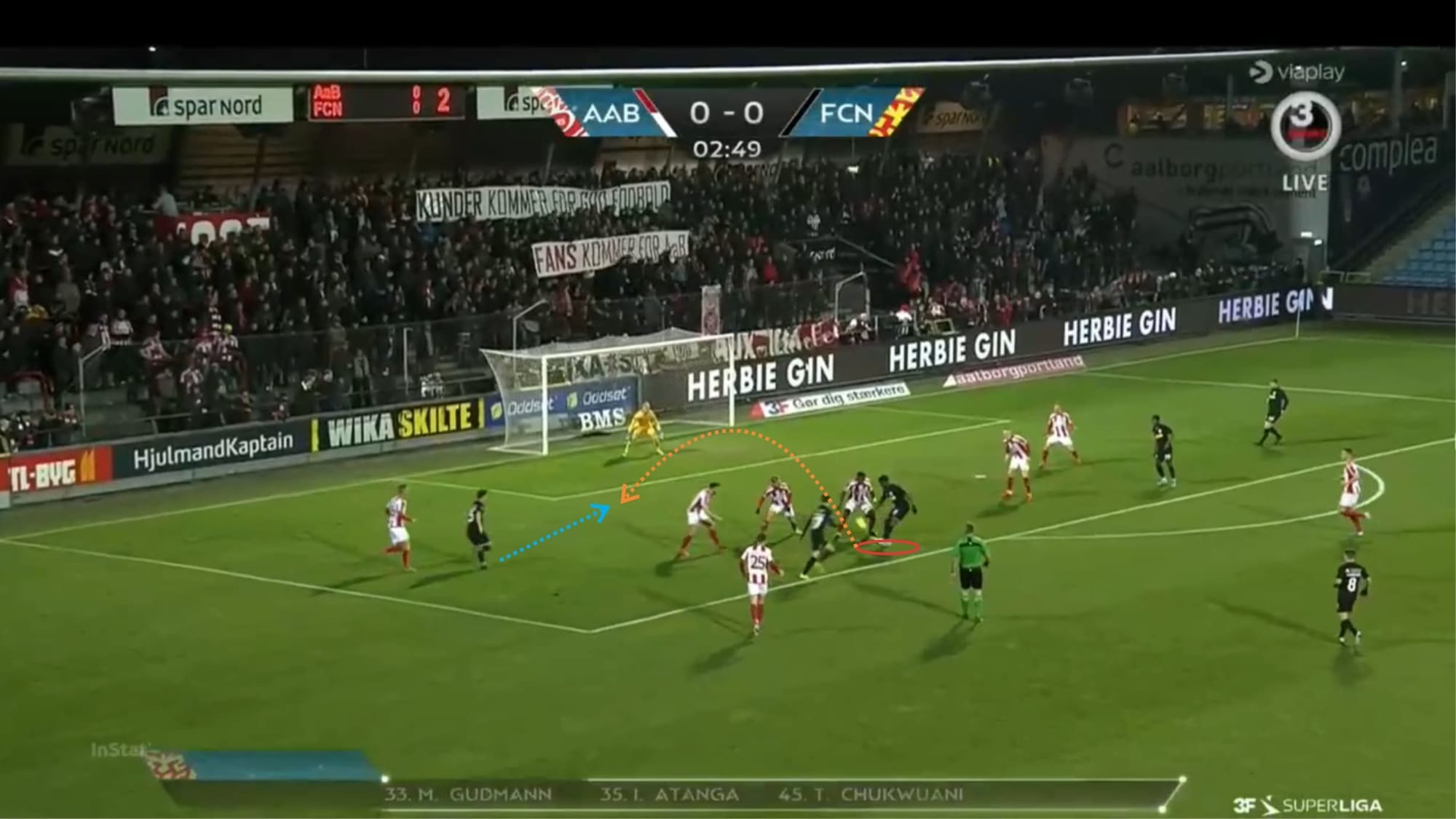
What’s quite impressive in Kudus’ game is his tendency to improvise in difficult situations. As you can see in the image above, Kudus spotted the run of the left wing-back, Mathias Rasmussen who was played onside. But it would be difficult to deliver a ground pass onto his path/his feet as the lane was essentially blocked by multiple defenders that were closing him down inside the box. He improvised by chipping the ball onto the path of Rasmussen and the left wing-back converted the pass into a goal by volleying the ball into the far corner of the net.
His tendency to improvise in difficult situations is definitely affected by his high level of confidence and flair on the ball that he possesses. He knows that he does have the technique to support his actions and he executed the action (in this case, the chipped pass) flawlessly.
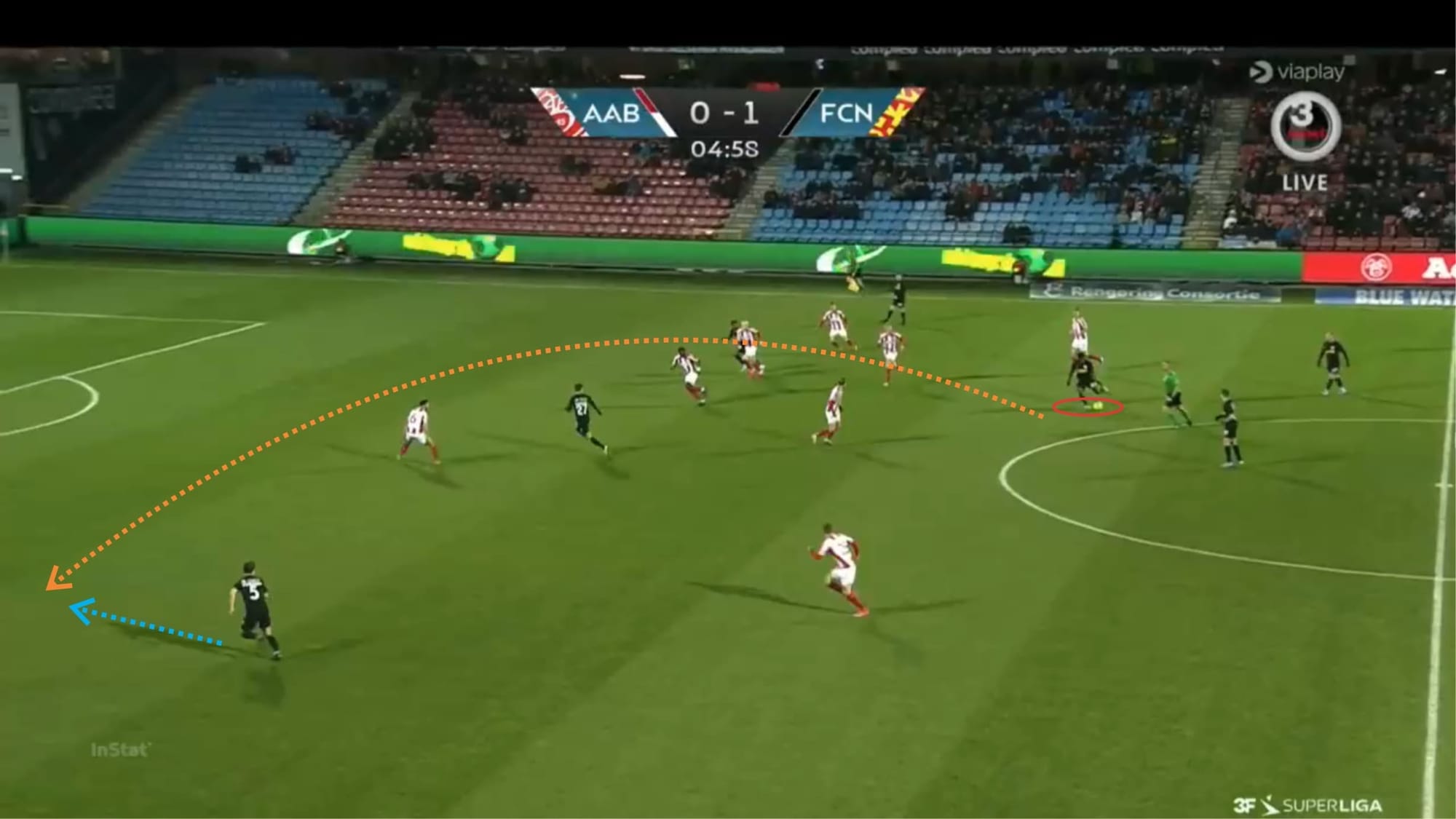
Kudus is proficient in distributing short, medium, and long passes. He has good control of power and his passes are often delivered with good pace, sharp enough so that the opposing defender will have a hard time dealing with it or trying to intercept it, but not too sharp as to make his own teammate receive uncomfortably.
Statistically, Kudus makes an average of 38.54 passes per game with a success rate of 89.3%. Those numbers are actually quite impressive for a player that likes to take risks and often plays in advanced areas (tighter space, more pressure, and more opponents around). He’s also quite vital in helping the team progress, registering an average of 7.67 progressive passes per game with a success rate of 80.8%.
For comparison, Liverpool’s Roberto Firmino makes an average of 32.87 passes per game with a success rate of 82.5% this season. He also records an average of 7.8 progressive passes with a 71.7% success rate. Not far different and some numbers and success rates are understandably lower, but still highly impressive considering the level the Brazilian is playing at. However, one can certainly expect a similar number if Kudus is to play at a higher level than he is currently playing in the future.
Defensive contribution
Not only in attack, but Kudus also participates actively in defence. He tracks back a lot, presses a lot, and shows aggression and bravery in physical duels. He’s not afraid to challenge bigger players despite knowing that there’s a bigger probability of him losing the duel rather than winning it. More importantly though, he shows determination, commitment and responsibility as whenever he or his teammate loses the ball, he’ll quickly chase down the ball carrier and try to win the ball back.
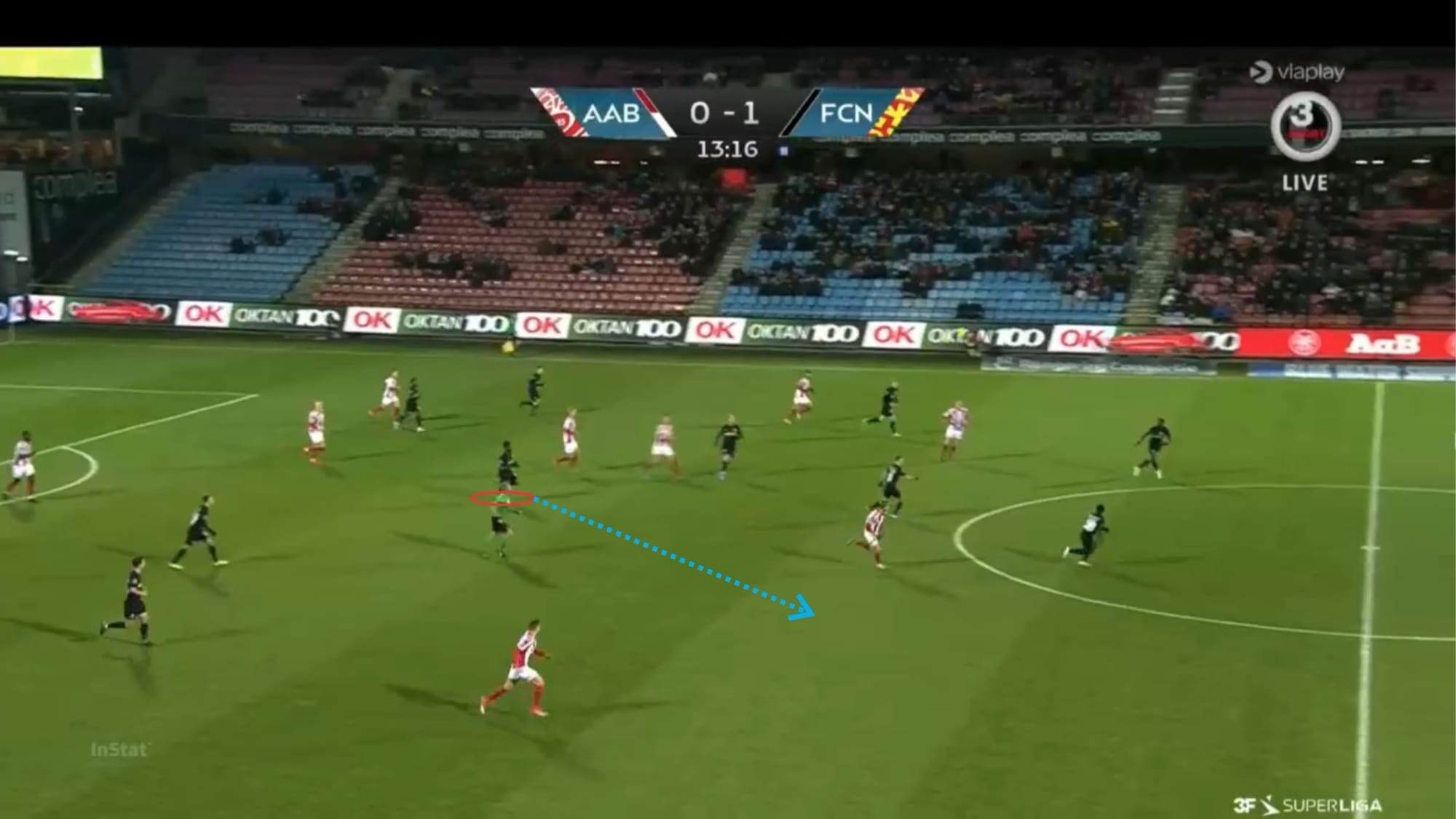
As you can see in the image above, Nordsjælland lost the ball in an advanced position and now in a defensive transition. Kudus quickly tracked back and chased down the ball carrier.
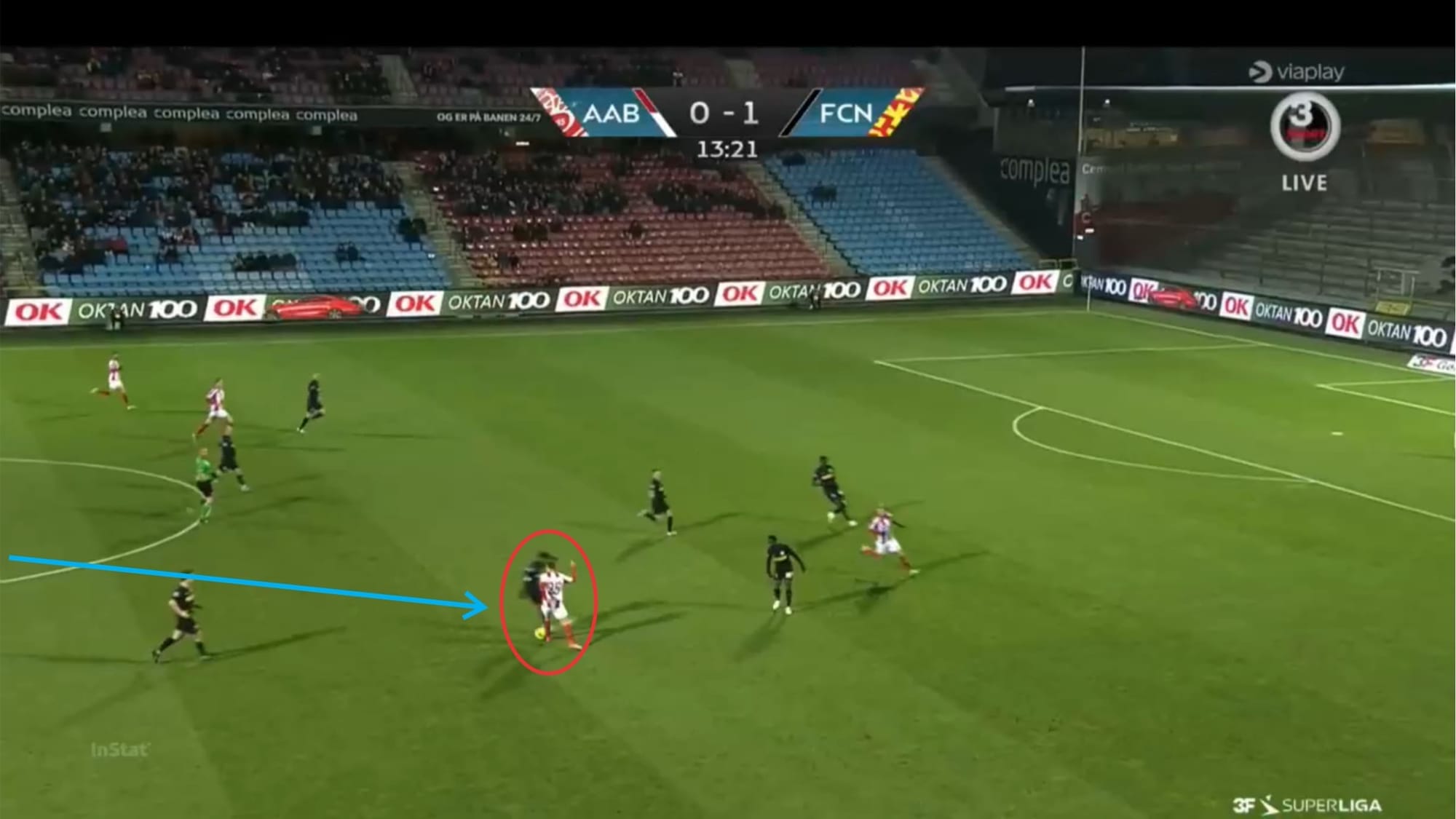
Using his explosiveness and pace, Kudus managed to catch up to the ball carrier and nicked the ball from behind, catching the ball-carrier by surprise. Nordsjælland then immediately launched another counter-attack.
Kudus’ energy, as well as explosiveness and pace, are very much useful when used in pressing. The young forward will often cause panic to the ball carrying central defender by coming at him with pace, and it’s not rare to see the opposing central defenders committing mistakes due to this. However, this could be a bit less effective against more skilled, more experienced, and more composed defenders.
Statistically, Kudus attempts an average of 5.6 defensive duels per game with a 58.8% success rate, which is quite impressive for a forward. He also averages around 4.96 recoveries per game, with 57.7% of them done in the opposition half.
Kudus very rarely attempts a sliding tackle and often will choose to commit a standing tackle.
Positioning and movements as well as tactical tendencies
As mentioned before in this tactical analysis/scout report, Kudus moves out of position a lot by dropping deep or roaming wide. But where exactly does he tend to move?
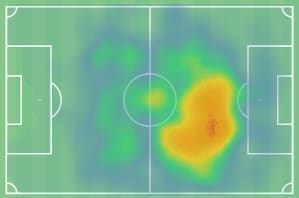
The heatmap above shows his positional tendency and the areas he usually covers this season. As you can see, this looks pretty much like the heatmap of a box-to-box midfielder or perhaps a hardworking advanced midfielder rather than a striker. He does sit in the final third a lot but quite rarely stays inside the box. He has this tendency to move a bit to the right, sitting in the right half-space and combining with the wide players there. By roaming wide, he helps his team combine by creating overloads on that side, allowing easier exchange and attracting pressure into that side that could result in underloaded areas on the opposite side of the pitch. With Nordsjælland also tending to attack and create chances from the flanks, this positional tendency is quite beneficial to his team.
When dropping, there’s always a possibility that the opposing defender will follow him and stick close to him which has been mentioned earlier in this tactical analysis/scout report.
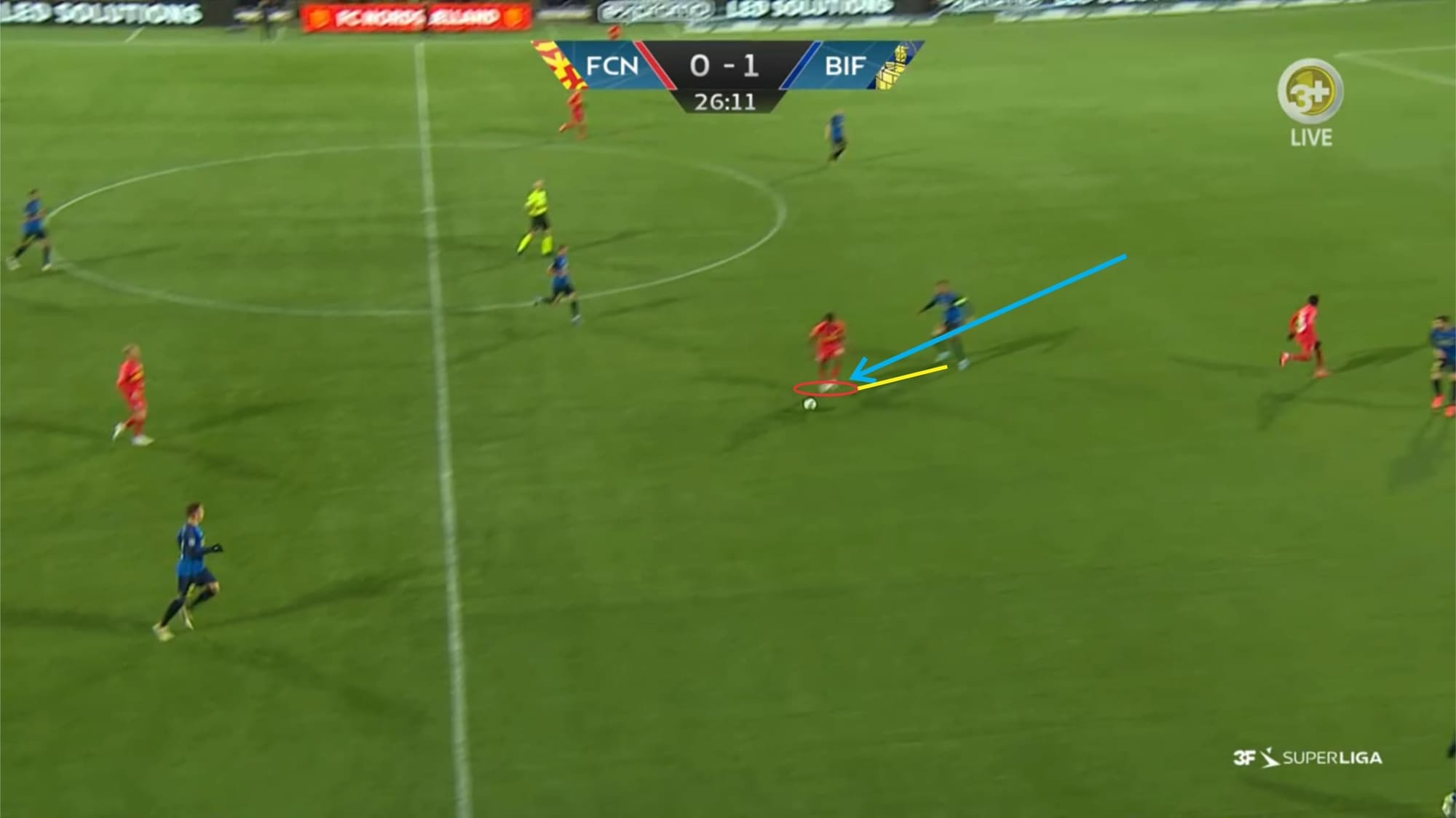
As in the picture above, you can see that Kudus was closely followed by Andreas Maxsø of Brøndby and the latter immediately put pressure on him when he received the ball. As you can see, with Maxsø following him tightly, Kudus has little space to turn and can be outmuscled by the defender, however, space behind him opens up which can be exploited. Usually in this situation, Kudus would play quicker, using fewer touches to combine with his teammate or to escape from his marker.
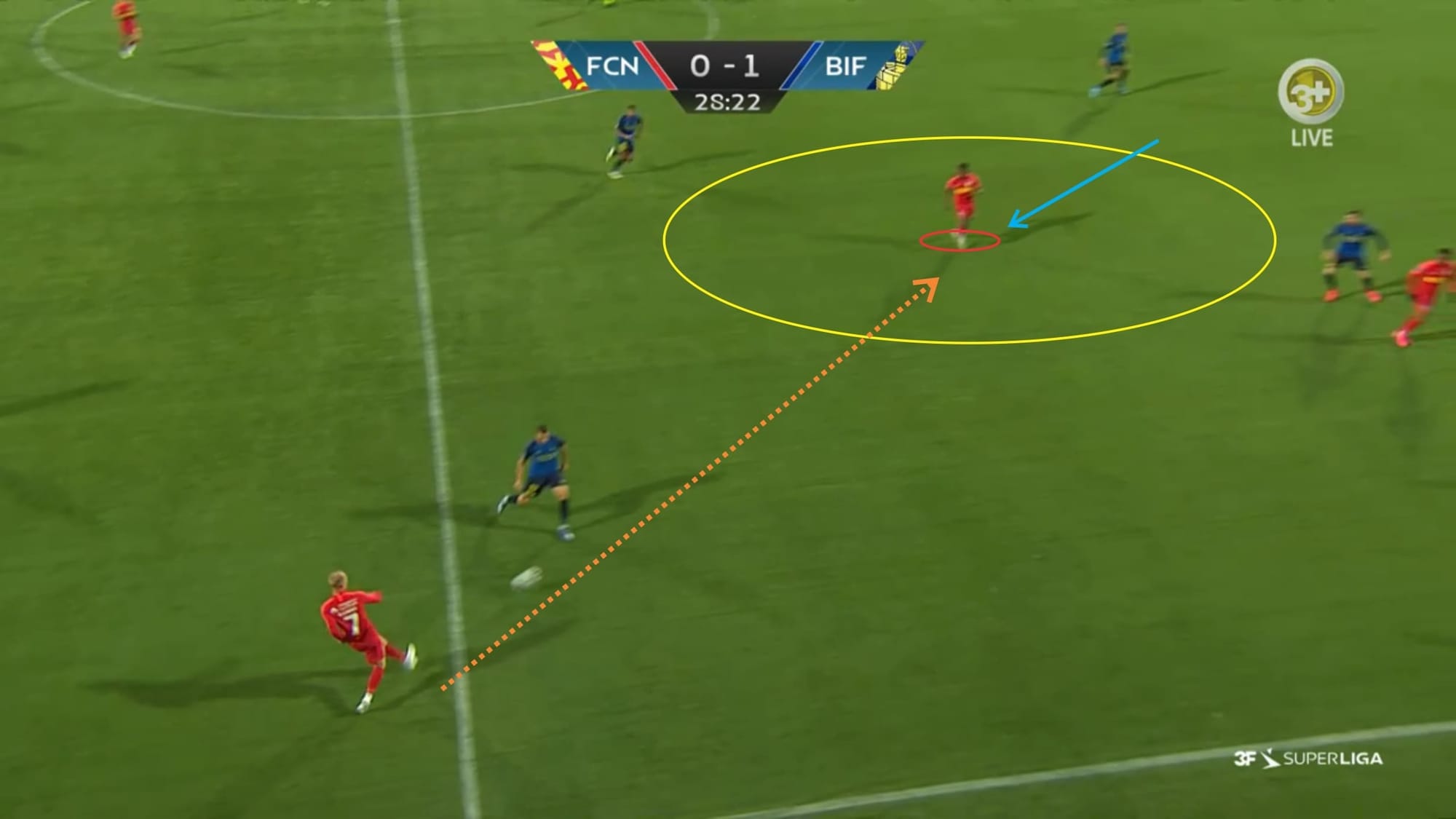
Some other times, the opposing defender will decide to not follow him which means that he’ll be left with some space between the lines. He’ll certainly be able to receive the ball and play with much more comfort in this situation so perhaps the best way to deal with him is to use a tight and aggressive approach plus using defensive cover if a defender is dragged out of position rather than giving him freedom in exchange of staying in position.
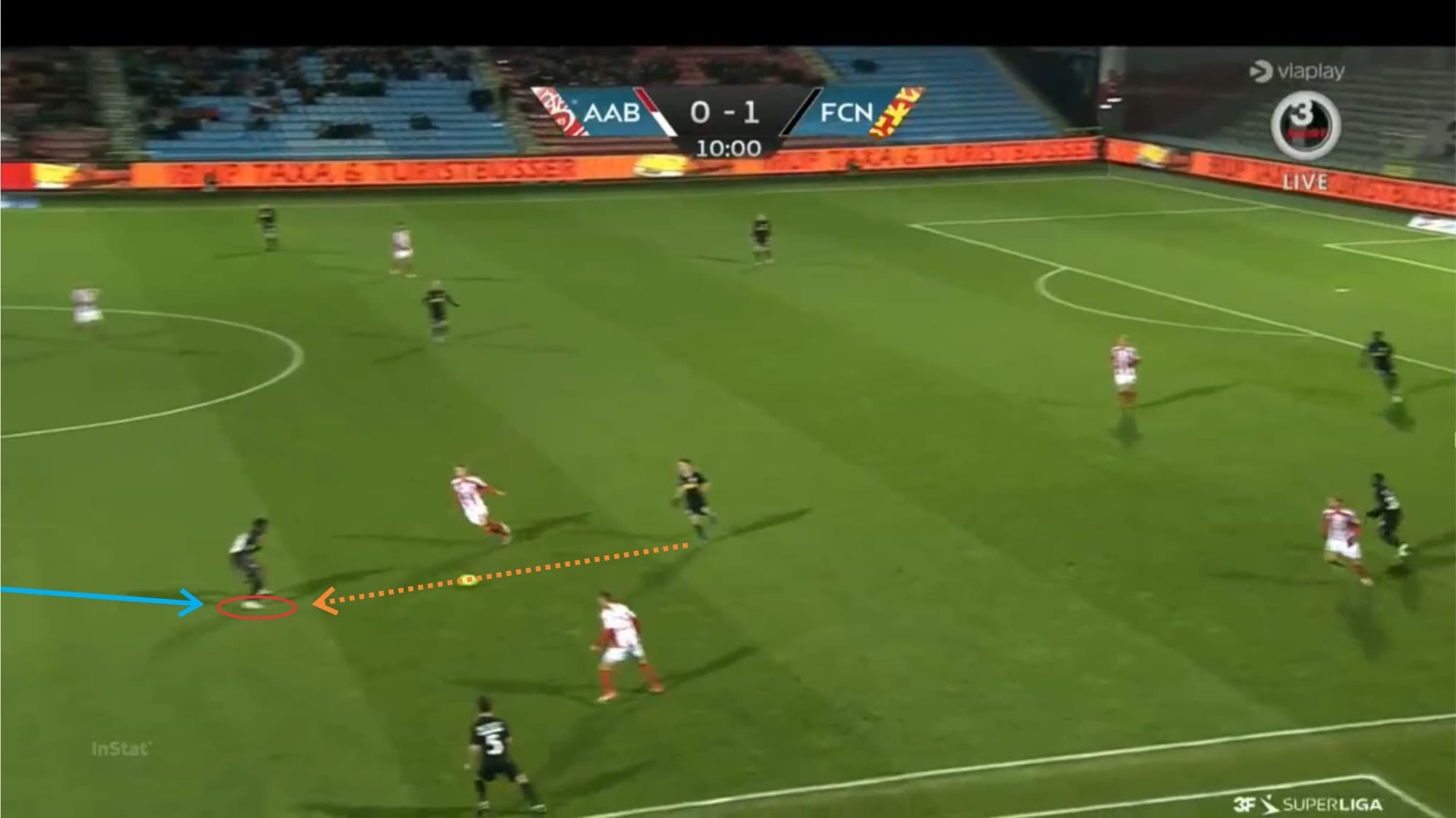
Above is an example of his highly impressive work rate and his contribution in transitions. Whenever Nordsjælland win back the ball in the defensive third, Kudus tends to drop to receive rather than make a forward run to exploit space as you can see in the picture above. Kudus acts as the link between the midfielders and the forwards not only in positional attacks but also in counter-attacks. This allows the team to be able to go forward quickly and safely albeit not directly.
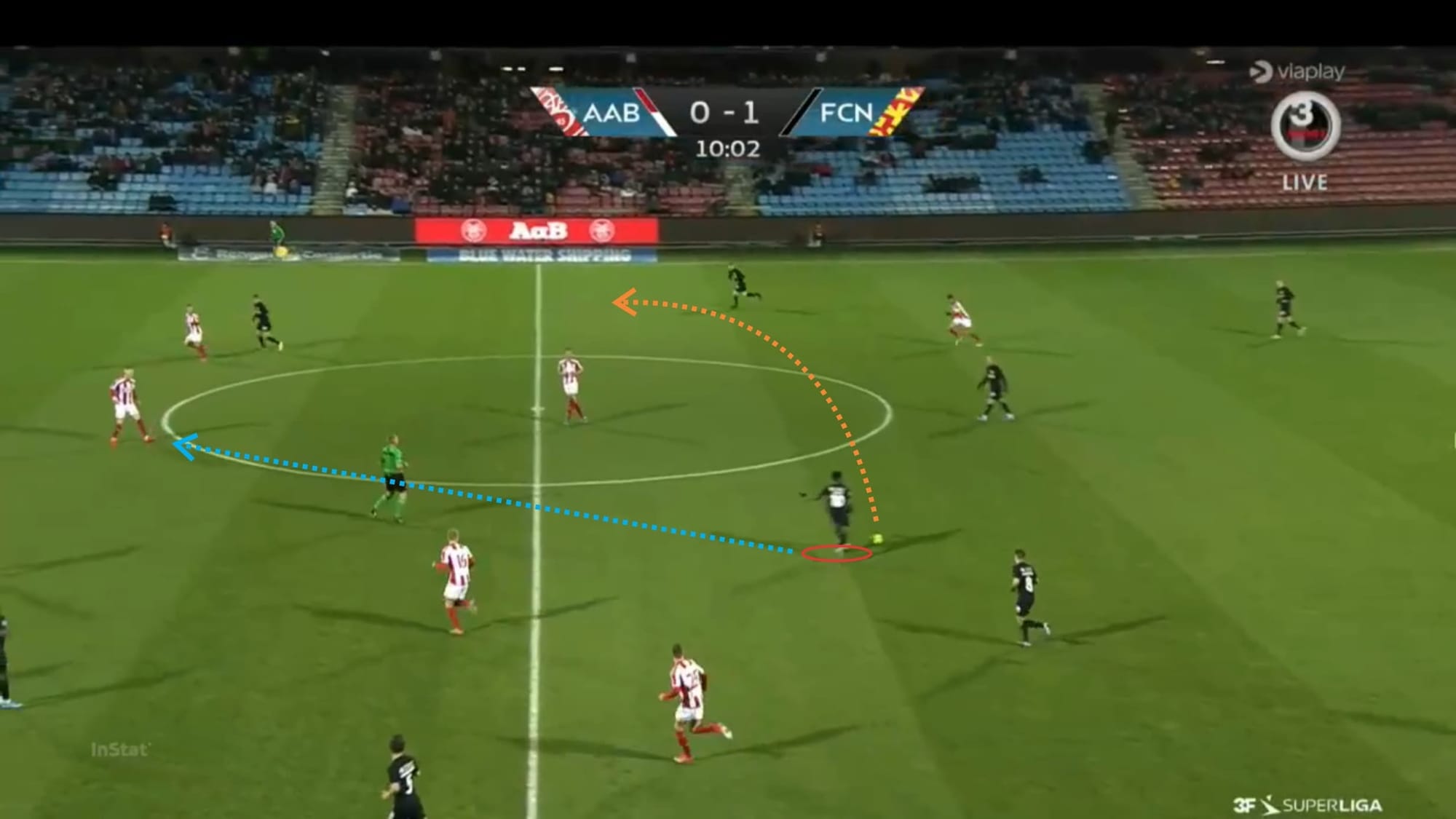
After receiving the ball Kudus would look to either deliver the ball into free space or drive forward himself. In this particular situation, the false nine played the ball towards the right wing-back on the opposite side of the pitch before quickly running forward to arrive at the box.
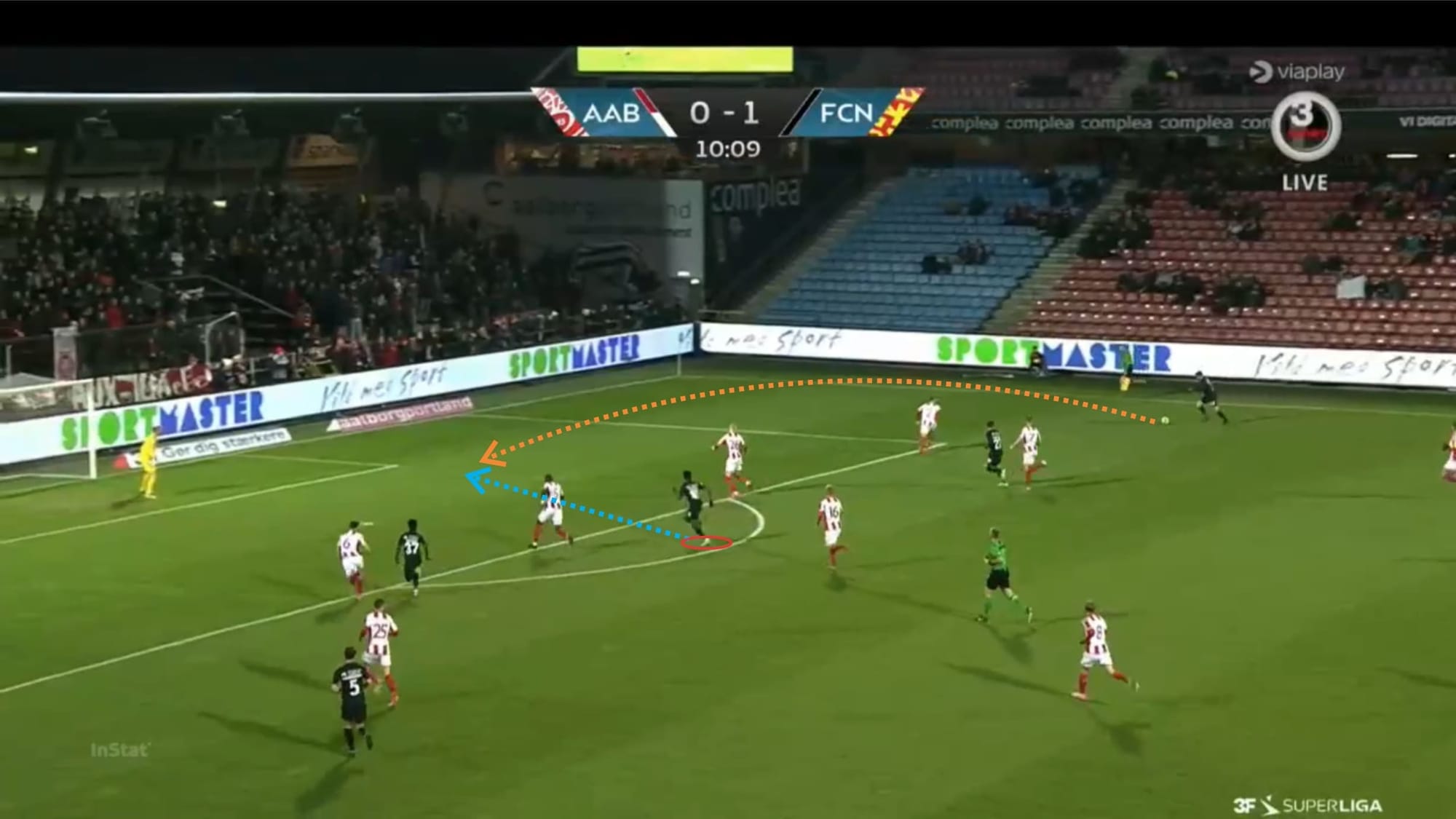
As you can see, in just a short amount of time, Kudus has already covered some distance and reached the penalty box to attack the cross.
What makes the Ghanaian forward very dangerous upfront is his recognition of space and the explosiveness and pace he possesses to exploit that space. He understands the triggers and he can react very quickly.
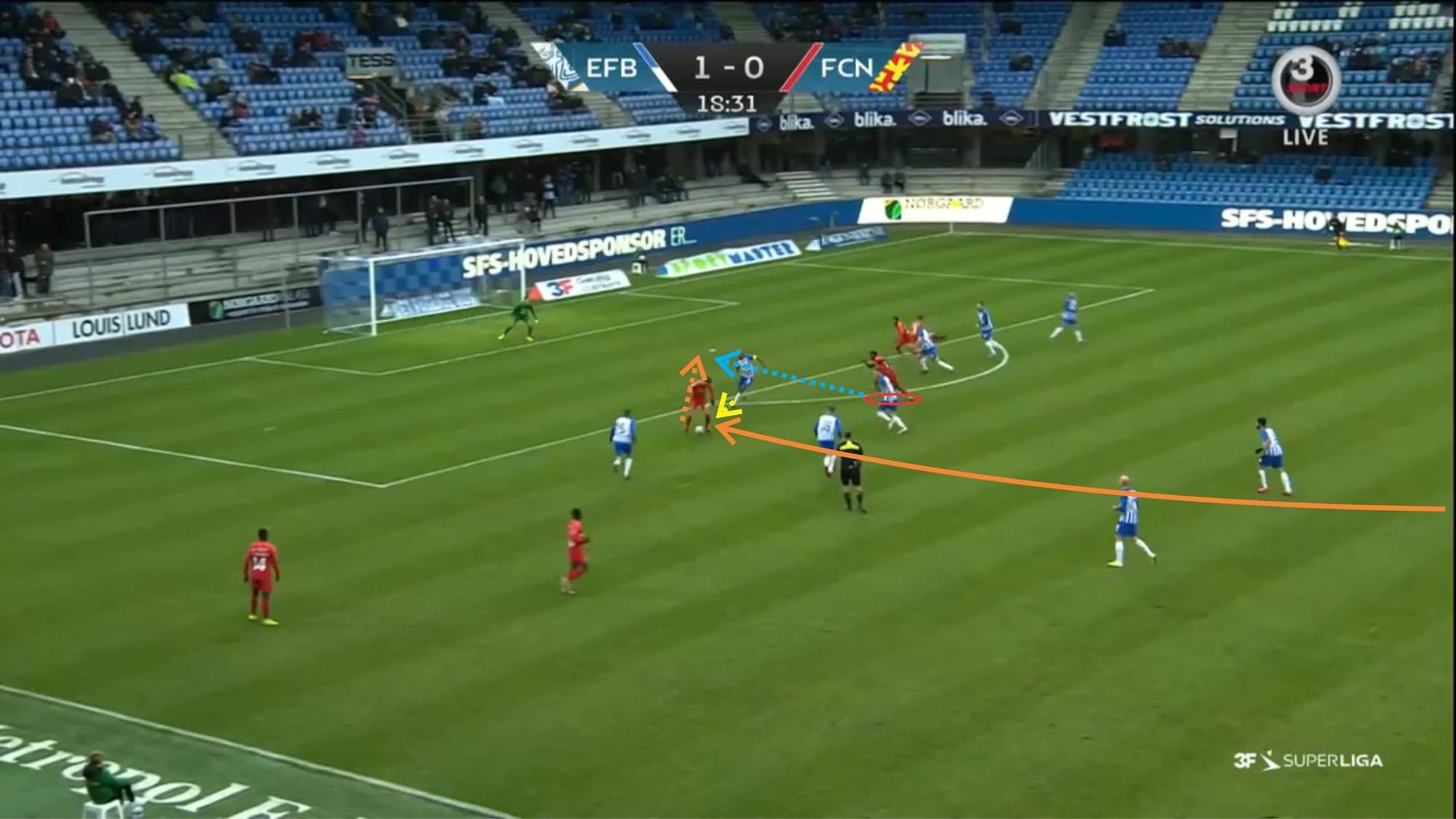
In the situation above, central midfielder Mikkel Rygaard Jensen delivered a sweet pass towards Mikkel Damsgaard who was sitting between the defensive and midfield lines of Esbjerg. Kudus was originally marked by the central defender in this situation, however, once Damsgaard received the ball, the central defender left Kudus and closed down Damsgaard. Kudus saw this opportunity and immediately ran into the space that was created. Damsgaard backheeled the ball onto the path of Kudus and the latter finished the ball with no mistake.
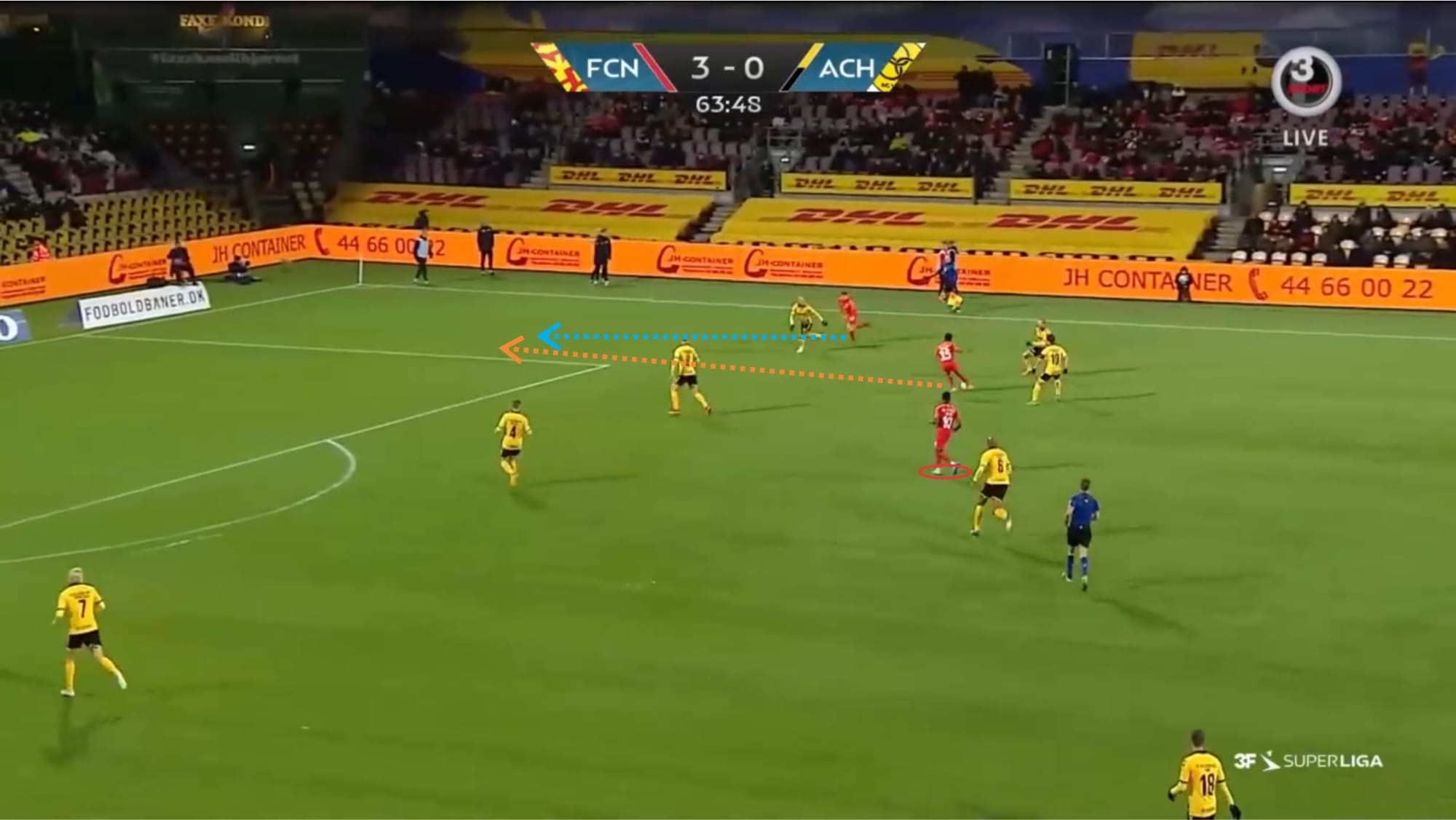
What’s often visible in Kudus’ game is his tendency to play with his marker using his speed and explosiveness and arrive late in the box. As mentioned before in this tactical analysis/scout report, he’d often accelerate forward and quickly decelerate, creating separation with his marker and then re-accelerating again. By doing this, he makes it hard for defenders to defend against him in the box as he’s often separated with his marker and left free in space.
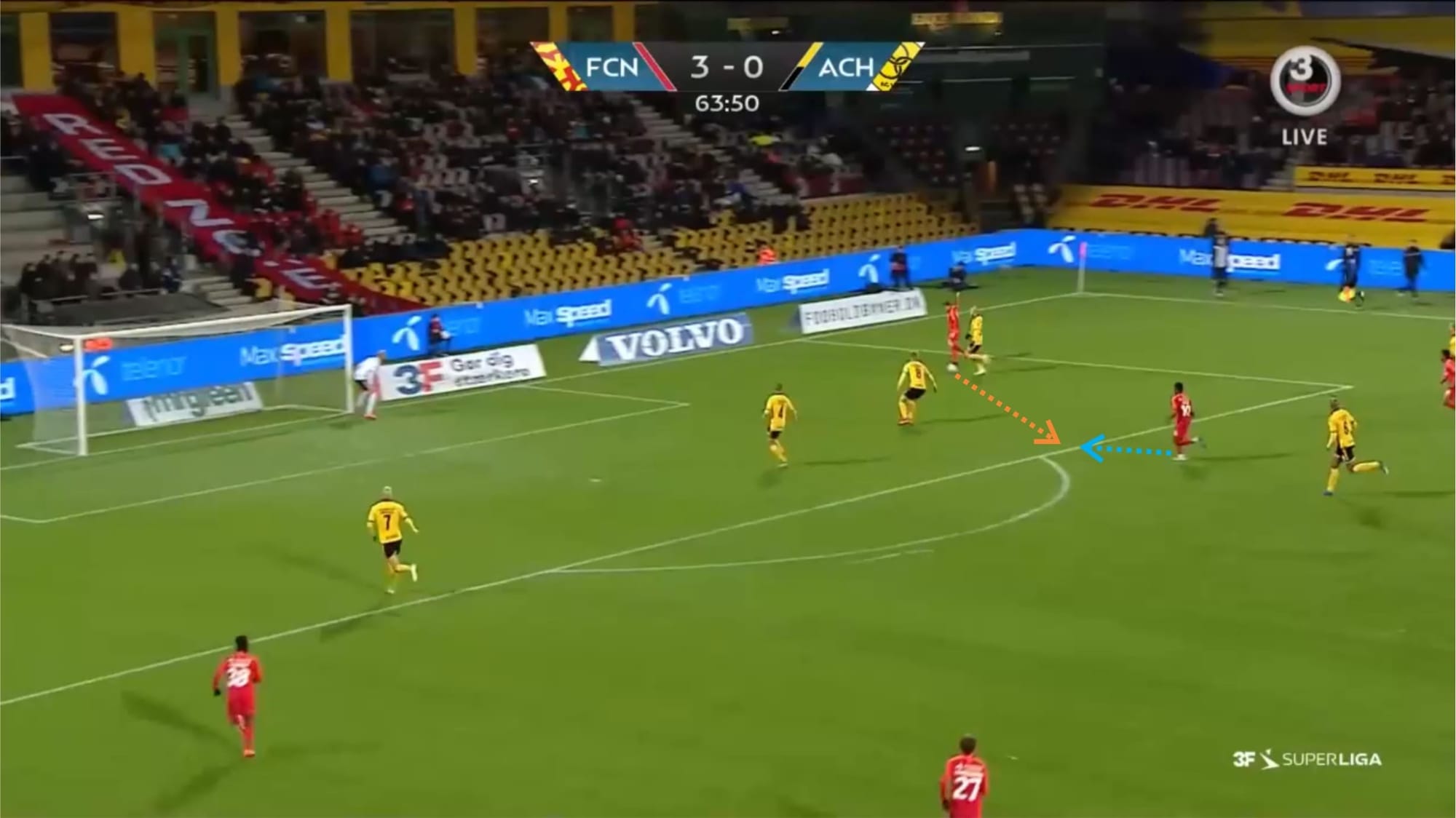
As you can see above, after slowing down (decelerating) to unmark himself, Kudus immediately accelerated into the box to receive his teammate’s cutback cross. In this particular situation, Kudus managed to convert the low cross into a goal by hitting the ball first time and putting it into the far corner of the net.
Conclusion
Kudus pretty much has it all. He already has great physicality and athleticism, perhaps greater than most players at the same age. His technical ability is exquisite all-around and he’s proficient in both offence and defence. An incredibly creative and energetic player with excellent playmaking and goalscoring ability – he’s a complete package and definitely the kind of player you’d love to have at your club, but hate to go against.
Premier League side Everton were actually rumoured to be interested in signing the Ghanaian wonderkid last summer but a move didn’t materialise. It would be interesting to see whether or not the Toffees would come back for him next summer, or perhaps another top European club would snap him up sometime in the future.





Comments